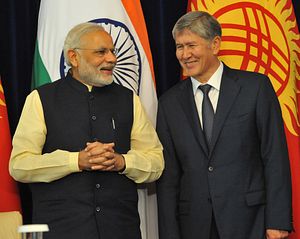Indian Prime Minister Narendra Modi was in Central Asia last week to enhance India’s linkages with the region at a time when major powers are competing for influence in the five nations of Kazakhstan, Kyrgyzstan, Tajikistan, Turkmenistan and Uzbekistan. Russia has made its determination to restore some of its historic influence over its former Soviet empire clear, but it is China that is making a real splash in the region. Though Russia and China are planning to enhance their engagement in Central Asia and have decided to coordinate their policies in the region, Beijing’s economic transformation of the lands west of its restive Xinjiang province has gathered pace in the last decade. With China spending billions of dollars on infrastructure and energy projects to link up the disjointed region, it has emerged as the main trading partner of four of the five Central Asian countries that gained independence from Moscow in 1991.
Unlike China which shares a border with Kazakhstan, Kyrgyzstan and Tajikistan, India’s transit to the region lies through Pakistan and Afghanistan, limiting India’s reach. Yet India’s growing interests in Central Asia are well-recognized. There is a growing convergence between the United States’ and India’s interests in the region, especially their reluctance to see the region fall under the exclusive influence of Russia or China. India was worried in the 1990s when Russian influence in Central Asia weakened substantially with the commensurate rise in China’s influence. This negatively impacted Indian threat perceptions which stabilized only after the growing U.S. presence in the region since 2001.
India’s ties with the regional states are growing. India views itself as a stabilizer and security provider in Central Asia and, with its growing economic clout, an attractive economic power for regional states. India’s interest in securing reliable energy supplies and trade through Central Asia remains substantial. Besides oil and gas, energy-hungry India is eyeing imports of uranium from both Kazakhstan and Uzbekistan.
India has long wanted to play a larger role in the Shanghai Cooperation Organization (SCO) and has been seeking support from individual member states for quite some time. India was admitted as an observer at the 2005 Astana Summit along with Iran and Pakistan. Though the 2010 Tashkent Summit lifted the moratorium on new membership, India’s role in the grouping has remained a marginal one. With Russian backing, India, along with Pakistan, will be granted full membership of the SCO next year.
Against this backdrop, Indian strategy has focused on developing strong bilateral partnerships in the region. With Uzbekistan, India has signed a pact on the import of over 2,000 tonnes of uranium much like the one India just signed with Kazakhstan. India is also exploring with Uzbekistan the possibility of extending the Friendship Railway Bridge to Herat in western Afghanistan. The requirements of energy security also postulate a continuing positive relationship with Moscow and friendly ties with all the Central Asian states. India must create firm ties among the energy exporting states of Central Asia, particularly Kazakhstan, Uzbekistan and, if possible, Turkmenistan
But India has so far failed to invest the diplomatic capital that the region demands. India tried to open an air facility in Ayni, Tajikistan, in 2002, to guard against growing instability in the region though nothing much happened on that front. And in 2010 the Tajik government officially made it clear that Russia is the only country likely to use the airbase in the future. This happened despite India spending around $70 million between 2002 and 2010 to renovate the Ayni base, extending the Ayni runway to 3,200 meters as well as installing state-of-the-art navigational and air defense equipment there. Meanwhile, China managed to win the competition for the Kashagan oilfield in Kazakhstan and the Dauletabad gas field in Turkmenistan. The much-hyped Turkmenistan-Afghanistan-Pakistan-India (TAPI) gas pipeline, which is supposed to transport gas from Turkmenistan across Afghanistan and Pakistan to India, is yet to get off the ground.
With a strategic approach towards Central Asia, China has made significant headway in the region with $10 billion in grants and aid to SCO members and developing regional linkages between Central Asia and its western regions. China’s trade with the Central Asian region crossed the $50 billion mark in 2013 whereas trade between Central Asia and India struggled to hit a paltry $2 billion. India’s lack of direct overland access to the region due to Pakistan’s reluctance in allowing Indian goods to pass through its territory has constrained Delhi’s trade interests from growing in the Central Asian region and consequently, trade with the region remains far below potential. India’s much touted International North-South Transport Corridor (INSTC), aimed at expanding India’s trade and investment links with Central Asia, remains a work in progress.
It is time New Delhi gives the region the attention it deserves. Otherwise, soon China will be able to claim the region as another of its backyards, and India will have to struggle to make it relevant despite its longstanding cultural links.

































